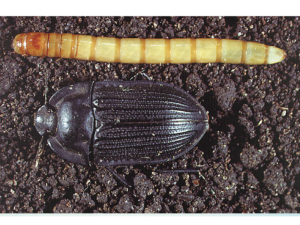Wireworm adults and larvae are relatively common soil pests, attacking all field crops. Adults feed on germinating shoots, and larvae feed on germinating seed, seedling roots and shoots causing poor plant vigour or death. Wireworms are most common in zero till, areas with high stubble, or weedy fallows. These are habitats and food sources that sustain the beetles and enable them to breed successfully.
Crops most at risk are generally late-planted winter crops or early-planted summer crops, and in particular spring sorghum because the one year lifecycle means that larvae have reached their most voracious and damaging final larval stage by September–November.
Monitoring
Adults may be present from December to May; the critical monitoring period is December to February.
Monitor for larvae pre-plant. Allow sufficient time to organise seed dressings or in-furrow sprays if required. There are two primary detection methods:
- Grain seed baiting (where baits of soaked untreated seed are shallowly buried throughout the paddock (at about 20 baits/100 ha). Dig up the baits a day after seedling emergence.
- Scraping the soil surface away carefully with a hand trowel. Look in paddocks with plant residue that have had recent rain where a surface crust has formed. Larvae can often be found at the wet-dry soil interface.
Suggested thresholds
Baits (DAF):
- Summer: An average of one or more wireworms per bait
- Winter: two or more wireworms per bait
Hand trowel (cesar): 10 larvae/m2
Control
Treatment for larvae needs to occur before the crop is sown. Refer to the APVMA website for products (including current permits) registered for the larvae. A wide range of seed can now be bought pre-treated with insecticide for soil insect pests.
Sprays and seed dressings for larval control are not effective against the adults. The optimal period for broadcasting treated cracked grain baits for beetle management is December to February.
Avoid repeatedly using just a single chemical group as Agrypnus species had developed resistance to several organochlorine compounds (which were widely used as seed and soil treatments before being banned in most countries).
Using press wheels at planting can assist in minimising insect damage by:
- injuring large insects,
- restricting the movement of larvae through the soil, and
- minimising soil moisture losses, enabling the seedlings to germinate more rapidly.
More information
Cesar:
Further reading
- Bailey, PT (ed) (2007) Pests of field crops and pastures – identification and control. CSIRO Publishing
- Gunning, R. V. and Forrester, N. W. (1984), Cyclodiene lindane resistance in Agrypnus variabilis (Candéze) (Coleoptera: Elateridae) in northern New South Wales. Australian Journal of Entomology, 23: 247–248.
- Radford, BJ and Allsopp, PG (1987) Use of insecticides and a press wheel to control soil insects affecting sorghum and sunflower establishment in southern Queensland. Journal of the Australian Entomological Society. 26 (2): 161-167
- Syngenta wireworm field guide (Canada) [300KB pdf file]




